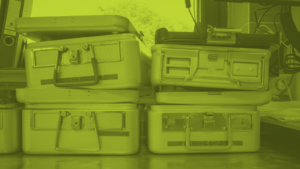Tackling Field Inventory Visibility: Reducing Risk and Costs through Advanced Tracking
Key Takeaways
- Field Inventory Visibility is a Major Challenge: Medical devices and loaner kits are spread across hospitals, sales reps, and regional storage, making real-time tracking difficult and increasing the risk of lost or underutilized inventory.
- Compliance with UDI and Traceability Mandates is Critical: Regulatory bodies require precise tracking of medical devices, but manual processes and disconnected systems create compliance gaps and audit vulnerabilities.
- Inefficient Inventory Management Leads to High Costs: Excess inventory, inaccurate demand forecasting, and rushed shipments drive up operational expenses and tie up working capital.
- Tier 1 Solutions Improve Tracking and Reduce Risk: A fully integrated approach with real-time tracking, automated returns, and centralized processing enhances visibility, reduces costs, and ensures compliance.

The Growing Complexity of Field Inventory Management
Field inventory management is one of the most challenging aspects of medical device logistics. Items such as orthopedic implants, surgical kits, and consignment inventory constantly move between hospitals, sales representatives’ vehicles, and regional storage hubs. Unlike warehouse stock, field inventory lacks centralized control, making real-time tracking difficult. These issues can lead to lost inventory, excess stock, and compliance risks.
Original Equipment Manufacturers (OEMs) face challenges in managing demand effectively due to a lack of complete visibility into their inventory’s location, usage, and replenishment needs. Misplaced or underutilized inventory leads to increased carrying costs, unnecessary replenishment orders, and emergency shipments, negatively impacting profitability.
Additionally, regulatory bodies such as the FDA (Unique Device Identification – UDI) and the European Union Medical Device Regulation (EU MDR) mandate precise tracking of all medical devices down to the serial or lot number. Manual monitoring and disconnected systems create compliance gaps, exposing manufacturers to potential audit failures and penalties.
Without an advanced tracking system and a Tier 1 integrated approach, medical device OEMs risk financial losses, regulatory fines, and increased operational costs due to inefficiencies in managing loaner kits and field inventory.

Why Field Inventory Visibility is a Critical Issue
Fragmented and Decentralized Inventory Control
- Medical devices are dispersed across hospitals, sales representatives’ vehicles, and storage hubs, making real-time tracking nearly impossible.
- A lack of visibility can lead to misplaced inventory, duplicate stock, and unnecessary replenishment orders.
- Inconsistencies in field inventory tracking can result in lost revenue and inefficiencies in meeting demand.
Compliance with UDI and Traceability Mandates
- Regulatory bodies require full traceability of each device by serial or lot number.
- Manual tracking and outdated systems complicate compliance, increasing the risk of audit failures and regulatory penalties.
- Without an automated tracking system, demonstrating full inventory traceability for compliance becomes resource-intensive and prone to errors.
Inaccurate Demand Forecasting and Excess Inventory
- Poor visibility into real-time inventory usage makes demand forecasting unreliable.
- Excess consignment stock sits idle, tying up working capital that OEMs could utilize elsewhere.
- Carrying unnecessary inventory increases costs without enhancing availability.
Without real-time inventory tracking, medical device OEMs may overstock in some locations while facing shortages in others, leading to inefficient and costly demand planning.
The Challenges of Managing Loaner and Consignment Kits
Loaner and consignment inventory are crucial in ensuring surgeons have the right instruments when and where they need them. However, efficiently managing these assets presents significant logistical challenges. Kits are frequently transported between hospitals, sales representatives, and processing centers, making it difficult to track their real-time status. Without a streamlined inventory visibility, replenishment, and returns system, OEMs face increased risks of misplaced kits, delayed surgeries, and higher operational costs. Inconsistent tracking and manual processes often lead to rushed shipments, missing instruments, and inefficiencies that negatively impact costs and compliance.
Complex Logistics of Loaner Kits and Consignment Inventory
Loaner kits require precise tracking from delivery to return to ensure proper replenishment. Poor visibility can lead to:
- Surgical delays due to missing instruments
- Rushed emergency shipments, which drive up costs
- Increased dissatisfaction among surgeons and hospitals
Manual, Error-Prone Returns and Reverse Logistics
The team manually inspects and counts the returned loaner kits, resulting in the following:
- Slow turnaround times
- Increased risk of inventory discrepancies
- Regulatory compliance risks
- Poor documentation of returns can result in lost devices, lost revenue, and inefficient sterilization and redeployment tracking.
The reverse logistics cycle remains a costly bottleneck in loaner kit and consignment inventory management without integrated tracking and automated returns processing.

How Advanced Tracking and Tier 1 Integration Address These Challenges
A Tier 1 service provider with advanced tracking technology eliminates blind spots in field inventory by integrating real-time tracking, logistics, and compliance management into a single, centralized system.
Real-Time Inventory Visibility
RFID, barcode scanning, and cloud-based tracking deliver instant location data for every device and loaner kit. This technology reduces lost inventory, eliminates redundant stock orders, and enhances demand forecasting accuracy.
Automated Loaner Kit and Consignment Tracking
The system tracks each loaner kit from delivery through return and sterilization, ensuring no instruments are lost or misplaced. This system eliminates manual data entry errors, prevents missing instruments, and reduces the need for last-minute emergency shipments.
UDI Compliance and Audit Readiness
Digital tracking systems confirm compliance with FDA Unique Device Identification (UDI) and European Union Medical Device Regulation (EU MDR) standards. Automated documentation simplifies audits and ensures full traceability of inventory movement.
Streamlined Reverse Logistics and Returns
Automated scanning and processing speed up loaner kit returns, lowering labor costs. Centralized processing hubs efficiently sterilize, inspect, and redeploy inventory for quicker turnaround times.
A Tier 1 integrated system enables OEMs to track every device in real-time, automate compliance, and enhance loaner kit availability while reducing costs.
Why a Tier 1 Service Provider Is the Best Solution
A Tier 1 service provider offers a more efficient alternative to traditional inventory management by consolidating tracking, compliance, and reverse logistics into a seamless system. This integration eliminates the inefficiencies of using multiple vendors, manual monitoring, and disconnected data sources.
Single-Point Inventory Management
- Consolidates tracking across hospitals, sales representatives, and storage facilities.
- Eliminates redundant stock orders and reduces the chances of misplaced inventory.
Seamless Management of Loaner Kits and Field Inventory
- Oversees the entire lifecycle of loaner kits, including tracking, sterilization, and replenishment.
- Minimizes rush shipments and downtime caused by missing kits or instruments.
Compliance Without the Hassle
- UDI-compliant tracking helps ensure that OEMs meet FDA and EU MDR requirements.
- Automated reporting simplifies audits and enhances traceability.
By selecting a Tier 1 provider with integrated tracking solutions, OEMs can gain better control over their field inventory, enhance operational efficiency, and reduce unnecessary costs.
A Smarter Approach to Field Inventory Management
Poor visibility into field inventory can lead to several issues, such as:
- Lost inventory and wasted capital
- Surgical delays due to missing kits or implants
- Risks of regulatory non-compliance
Advanced tracking solutions, combined with a Tier 1 service provider, can eliminate these challenges by providing:
- Real-time inventory visibility
- Seamless logistics for loaner kits and consignment
- Automated compliance and audit readiness
By integrating tracking, compliance, and logistics into a centralized system, medical device OEMs can reduce costs, improve efficiency, and easily maintain regulatory compliance.







